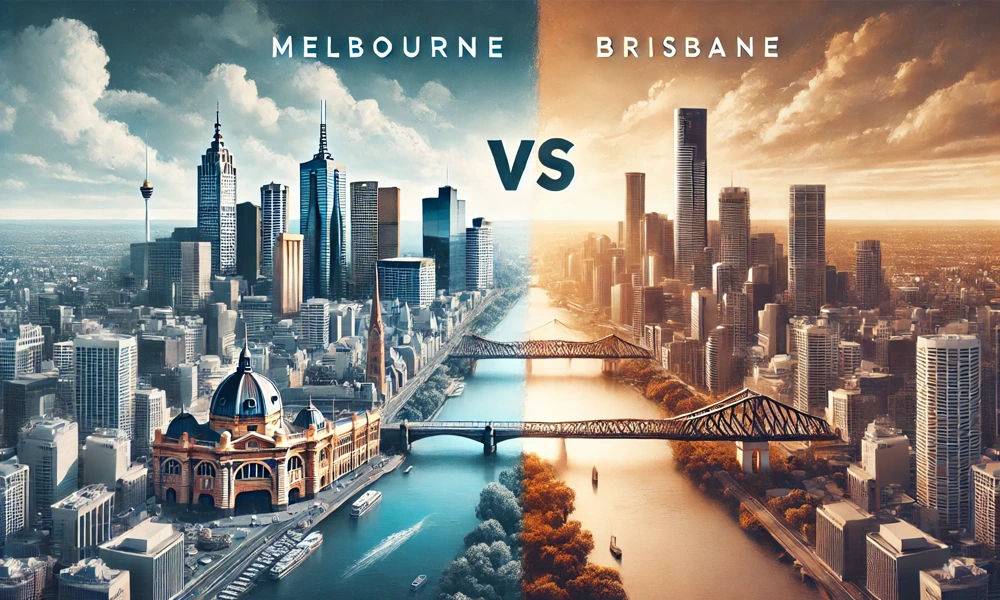Melbourne vs Brisbane: Which City is Best for Living, Studying, and Exploring?
Table of Contents
Deciding between Melbourne and Brisbane as your destination for living, studying, and exploring in Australia can be both exciting and challenging. These two dynamic cities offer distinct lifestyles, educational opportunities, and cultural experiences that cater to diverse student needs. Melbourne, often celebrated as Australia’s cultural capital, is renowned for its vibrant arts scene, world-class universities, and thriving urban life. On the other hand, Brisbane, known for its sunny weather and laid-back lifestyle, is gaining popularity among international students for its affordability and growing job market.
From comparing the cost of living and top universities to job opportunities, public transportation, and student accommodation, this guide dives deep into the key aspects of both cities. Whether you’re drawn to Melbourne’s cosmopolitan charm or Brisbane’s relaxed vibe, understanding these factors will help you make an informed decision about which city best suits your academic and personal aspirations.
Melbourne VS Brisbane: Cost of Living
When comparing Melbourne vs Brisbane in terms of the cost of living, it’s essential to consider factors such as rent, groceries, dining, and overall purchasing power. Melbourne is often regarded as a more cosmopolitan city with higher living expenses, while Brisbane is known for its affordability and relaxed lifestyle. However, actual costs can vary based on location, lifestyle preferences, and accommodation choices. Melbourne, often referred to as Australia’s cultural capital, is renowned for its vibrant arts scene, coffee culture, and dynamic city life. This cosmopolitan charm, however, comes with a slightly higher price tag in some areas. On the other hand, Brisbane, known for its sunny weather, relaxed lifestyle, and growing urban development, tends to offer a more affordable living experience, particularly for housing and daily essentials. Here’s a tabular comparison of the cost of living in Melbourne vs Brisbane:
| Expense Type | Melbourne (AUD) | Brisbane (AUD) | Highlights |
| Average Weekly Rent | $520 | $580 | Brisbane rents are higher for houses, but apartments in Melbourne may cost more. |
| Groceries | 1.39% lower | 2.4% cheaper | Mixed reports, depending on the source and goods. |
| Dining Out | 2.22% higher | 0.68% lower | Brisbane is more budget-friendly for restaurants. |
| Net Salary (Monthly) | $5,100 | $5,250 | Brisbane offers slightly higher average salaries. |
| Consumer Prices | 0.06% higher | — | Almost negligible difference in consumer prices. |
| Local Purchasing Power | 8.12% higher | — | Melbourne offers better purchasing power. |
Melbourne VS Brisbane: Top Universities
Australia is renowned for its world-class education system, and both Melbourne and Brisbane boast some of the top universities in the country, attracting students globally. Melbourne, often celebrated as Australia’s cultural capital, is home to prestigious institutions and a vibrant student life. On the other hand, Brisbane offers a sunny, friendly environment and universities with a strong focus on research and innovation. Deciding between Melbourne and Brisbane universities depends on personal preferences, career goals, and lifestyle aspirations. Melbourne is a hub for academic excellence, with universities consistently ranked among the best globally. It’s status as the fourth-best city in the world for studying abroad. Brisbane, often lauded for its laid-back lifestyle, cultural diversity, and proximity to stunning beaches, is a preferred destination for international students seeking a balanced lifestyle. The table below provides a comparison of some of the top universities in Melbourne vs Brisbane, including their rankings and tuition fees for international students:
| City | University | Ranking (2024) | Global Ranking | Estimated Tuition Fees (AUD/year) |
| Melbourne | University of Melbourne | #2 in Australia (THE) | #37 in the World (THE) | $40,000–$55,000 |
| Melbourne | Monash University | #2 in Melbourne (THE) | #57 in the World (QS) | $37,000–$52,000 |
| Melbourne | Swinburne University of Technology | #3 in Melbourne (THE) | #321 in the World (QS) | $30,000–$45,000 |
| Melbourne | Deakin University | #4 in Melbourne (THE) | #266 in the World (QS) | $28,000–$38,000 |
| Brisbane | University of Queensland (UQ) | #2 in Australia (QS) | #40 in the World (QS) | $35,000–$55,000 |
| Brisbane | Griffith University | #3 in Brisbane (THE) | #300–350 in the World (QS) | $28,000–$40,000 |
| Brisbane | Notre Dame Australia | Not Ranked Globally (THE/QS) | Regional Presence | $25,000–$35,000 |
Melbourne VS Brisbane: Job Opportunities
When choosing between Melbourne and Brisbane for job opportunities, the decision often depends on individual career goals, industry preferences, and lifestyle priorities. Melbourne, as one of Australia’s largest cities, offers a vast and diverse job market across numerous industries. On the other hand, Brisbane, though smaller, is experiencing a surge in job growth fueled by infrastructure developments and upcoming global events like the 2032 Olympics. Melbourne’s job market thrives in fields such as finance, technology, education, healthcare, and creative industries. Meanwhile, Brisbane stands out for its opportunities in construction, mining, tourism, and renewable energy. Despite its smaller size, Brisbane’s rapidly growing sectors make it a viable choice for specific career paths, especially for those looking for roles in sustainable industries or large-scale infrastructure projects. Below is a detailed table highlighting the differences and strengths of the job markets in Melbourne vs Brisbane:
| Aspect | Melbourne | Brisbane |
| Industry Diversity | Strong presence in finance, technology, education, healthcare, and creative arts. | Concentrated growth in construction, mining, tourism, and renewable energy. |
| Emerging Sectors | Continues to grow in technology, professional services, and healthcare. | Surge in infrastructure jobs due to the 2032 Olympics and renewable energy projects. |
| Job Market Size | Larger overall job market with more diverse listings. | Smaller market but rapid growth in specific high-demand industries. |
| Major Employers | ANZ, NAB, Telstra, Victoria State Government, Monash Health. | Rio Tinto, Suncorp, Queensland Government, Brisbane City Council. |
| Average Salary (AUD) | $70,000–$120,000 (varies by sector). | $65,000–$110,000 (varies by sector). |
| Unemployment Rate | ~3.3% (2023 estimate). | ~3.7% (2023 estimate). |
| Cost of Living Impact | Higher living costs may offset higher salaries. | Lower living costs provide better savings potential. |
| Global Events Impact | Stable job growth due to established industries. | Rapid job creation due to 2032 Olympics-related projects. |
Melbourne VS Brisbane: Public Transportation
Public transportation plays a vital role in daily commuting, especially for students and professionals. Both Melbourne and Brisbane, Australia, boast efficient systems comprising buses, trains, and ferries. While Melbourne’s network is renowned for its extensive reach and affordability, Brisbane’s transportation system offers convenience but at a slightly higher cost. Choosing between the two cities’ public transport systems often depends on your specific commuting needs, budget, and proximity to available services. Melbourne has a comprehensive transport network covering a larger area, making it highly accessible. However, Brisbane’s public transport, although smaller in scale, focuses on efficiency with high-frequency bus services and ferries. Here’s an in-depth look at their public transportation systems:
| Aspect | Melbourne | Brisbane |
| Cost | Generally more affordable. A daily cap for Myki cards helps reduce expenses for frequent travelers. | Higher transportation costs compared to Melbourne. Accounts for nearly 20% of household income. |
| Network Size | Extensive network of trains, trams, and buses covering a larger area. | Smaller network but efficient, with buses, trains, and ferries connecting key areas. |
| Accessibility | High-frequency services in both central and suburban areas. | Limited reach in suburban and rural areas; poorer access in economically disadvantaged zones. |
| Key Services | Features a well-connected tram system, the only one of its kind in Australia. | Offers high-frequency bus services like CityGlider and a well-utilized ferry network. |
| Transport Cards | Myki card: Available at ticket windows, vending machines, and convenience stores. | Go Card: Offers flexibility and can be purchased at various locations. |
| Special Benefits | Free tram travel within Melbourne’s CBD. | Free off-peak travel for seniors, adding value for older commuters. |
| Sustainability | Expanding efforts to integrate electric buses and sustainable energy in the transport system. | Focused on improving eco-friendly ferry and bus services to align with renewable energy initiatives. |
| Affordability | Approximately 15–18% of household income is spent on transport. | Accounts for around 20% of household income, slightly higher than Melbourne. |
Melbourne VS Brisbane: Student Accommodation
Finding the right student accommodation is crucial for a fulfilling academic experience, and both Melbourne and Brisbane offer unique advantages. Melbourne, often hailed as one of the world’s most livable cities, boasts a wide variety of student housing options and a vibrant student culture. Meanwhile, Brisbane is an attractive option for those seeking more affordable accommodation in a warm climate. Whether it’s the range of housing styles or proximity to universities, both cities cater to diverse student needs. Melbourne stands out for its extensive options and cosmopolitan student lifestyle, while Brisbane shines with its affordability and a growing reputation as a student-friendly city. Below is a detailed comparison of Student accommodation in Melbourne vs Brisbane:
| Aspect | Melbourne | Brisbane |
| Variety and Availability | Larger selection of student accommodations near universities, such as Scape and UniLodge. | Moderate variety but growing with options like Scape and Student One. |
| Cost | Generally higher but offers affordable options depending on location. | Slightly more affordable on average, though prices vary by area. |
| Student Life | Thriving cultural scene, diverse events, and strong community feel. | Known for its friendly vibe, outdoor lifestyle, and proximity to beaches. |
| Climate | Cooler winters with a more temperate climate year-round. | Warmer, subtropical climate ideal for outdoor activities. |
| Popular Student Accommodations | Unilodge Victoria University, Scape Carlton, Melbourne Victoria Markets, Campus Melbourne, Student Village The University Of Melbourne Campus | Student One Wharf Street, Scape South Bank, Unilodge Park Central, Unilodge Herston, Student One Elizabeth Street |
Conclusion
Choosing between Melbourne and Brisbane ultimately depends on your personal preferences, career goals, and budget. Melbourne stands out for its diverse job opportunities, extensive public transportation network, and vibrant cultural and student life. It’s a hub for those seeking a dynamic city experience and access to globally ranked universities. In contrast, Brisbane offers a more affordable cost of living, a relaxed lifestyle, and a fast-growing job market, especially in sectors like construction, renewable energy, and tourism. Its sunny climate and proximity to natural attractions make it a great choice for students who value outdoor activities and a tight-knit community. Whether you prefer Melbourne’s fast-paced, cosmopolitan environment or Brisbane’s warm, welcoming atmosphere, both cities promise a fulfilling student experience in Australia. Weigh your priorities carefully and consider all aspects to find the perfect match for your academic journey and personal growth.
Frequently Asked Questions
Is Melbourne or Brisbane Better to Live In?
When comparing Melbourne vs Brisbane, Brisbane is often regarded as the more affordable option, particularly in terms of housing costs. With a variety of options ranging from modern apartments to spacious family homes, Brisbane offers lower rental prices compared to Melbourne. This makes it an appealing choice for individuals and families looking to save on living expenses while enjoying a relaxed lifestyle.
Which is Better to Visit: Brisbane or Melbourne?
The answer depends on your interests. Brisbane often stands out for its abundance of tourist-friendly activities and attractions, such as scuba diving, snorkeling, and hiking. Melbourne, while larger, is more renowned for its vibrant food culture, arts scene, and cosmopolitan city vibe. If you’re seeking outdoor adventures, Brisbane may be the better choice. For those drawn to culture, dining, and urban experiences, Melbourne shines.
What Does Brisbane Have That Melbourne Doesn't?
Brisbane offers a distinctive blend of small-town charm and big-city amenities. Despite rapid urban development, it retains a relaxed and friendly vibe. The locals are welcoming, traffic is less hectic, and the emphasis on work-life balance is evident. These qualities give Brisbane a unique edge over Melbourne and other Australian cities for those seeking a laid-back yet thriving environment.
Why Are People Moving From Melbourne to Brisbane?
A significant reason why people are relocating from Melbourne to Brisbane is affordability, particularly in terms of housing. Brisbane offers larger and more affordable homes, making it an ideal destination for families. Additionally, Brisbane's warmer weather, outdoor lifestyle, and growing job market contribute to its appeal as a top choice for relocation.
Which City Is Best to Live In Australia?
For many, Melbourne takes the crown as the best city to live in Australia, especially in 2024. Renowned as the country’s cultural capital, Melbourne boasts a rich arts scene, diverse food offerings, and countless festivals. Its vibrant community and well-established public infrastructure make it a preferred choice for those seeking a dynamic and enriching urban lifestyle. However, Brisbane’s affordability, relaxed vibe, and sunny climate make it a compelling contender for those prioritizing cost-effectiveness and outdoor living.







